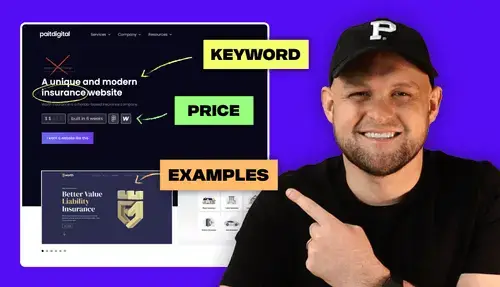We understand that things happen and situations change, but we hope you had a good experience with us!
Unfortunately, once a member leaves you can no longer reapply to join again down the road.
Are you sure you want to leave us?
.svg)
The Perfect Portfolio Formula
Learn to create a mind-blowing portfolio that makes clients and employers desperate to work with you.

What you will learn in this training
- Basics of a high-converting portfolio
- Psychological cues to generate more clients from your portfolio
- Examples of good and bad portfolios
- Case study template to turn your portfolio into a sales funnel
- How to create a portfolio you’re proud of
Pait Digital’s portfolio stats from last 3 months
- $130,000 in website work
- $72,000 in ongoing SEO contracts
- $11,000 in migration work
- So even though no portfolio is perfect, including ours, we do know how to do some things that are working really well and want to share those with you all.
Theory Behind Your Portfolio
Positioning yourself as an expert:
- No matter where you are on your journey, you are an expert to someone
- What makes people perceive you as an expert?
- You can prove you are good at what you do
- You are certified by or affiliated with a trustworthy brand or organization
- You have a following or someone who can vouch for you
- You have a track record
- You are confident in yourself
- You’ve been at it for a long time
Creating the perfect positioning for web design portfolios
“I have to create the highest quality work”
This is just not true - we don’t need to be the best to be very successful.
Instead, we just need to focus on creating high quality work.
“I have to have a unique and irresistible offer”
Most of us stick with traditional agency model and are successful.
Instead, we need to have a powerful offer.
“I need to be an exceptional salesperson”
While this is an essential skill, you don’t want to be a pushy salesperson.
Instead, you need solid sales skills.
“I need to offer the lowest prices”
This is a race to the bottom and you will get worse clients this way.
Instead, offer reasonable prices.
“I need to be in an industry with low competition”
As a web designer, this is not likely, as there are many web designers in the market.
Instead, you make sure you are competitive in the industry.
“I need to be the most well-known web designer”
Again, not very likely in this industry.
Instead, focus on being well-known.
What makes you different from the next designer?
- My favorite YouTube channel right now is a group of friends who play golf together, called the “Good Good”
- In terms of skills, they aren’t exceptional golfers. But they are the most successful golf channel on YouTube.
- Why? They offer the perfect combination of unique personality and skills to entertain and engage
- You don’t have to be the best, you just have to be different!
Things that are going to help you get hired
- Are you a perfect fit?
- Are you more likable?
- Have you been referred?
- Are you from their area?
How people find you will determine your portfolio strategy
- Are they warm/cold?
- Do they know they want/need your services?
- Are they local/national/international?
- Are they in a particular industry?
- Do they have a particular problem?
- All of these factors determine how you speak on your portfolio copy and what you want to focus on.
Actionable Portfolio Tips
We asked Past Pait Digital clients their priorities when looking at a portfolio, in order of highest to lowest:
- Your work - can you build what I want?
- Trustworthiness - will you screw me over?
- Price - are you within my budget?
- Process - are you easy to work with?
- Availability - can you get it done when I need it?
On your portfolio, don’t:
- Don’t teach them about web design “e.g. ‘Your website is your #1 tool in your business, so make sure it is good!’”
- Don’t talk about features or tools you use, they don’t care about these, they care about results
- Don’t keep secrets or be vague, the more transparent you are, the more people will trust you
On your portfolio, do:
- Show them your work NOW!
- Show results and benefits
- Be transparent about your process
The psychology behind the stop sign: People trust those with a symbol of authority.
Powerful symbols of authority
- Badges
- Stars
- Company logos
- Faces
- Lock, shield, checkmark
- The colors blue, orange and green
- Familiar fonts, layouts and styles
- Personalized copy
K.I.S.S. (Keep it simple stupid!)
- Appeal to a wide range of prospects
- Focus on your client projects and not your own site
- Make it easy to navigate and consume
Two viewport rule:
Assume that no one will make it past the first two viewports. So make sure you capitalize on that real estate.
Homepage
- State what you do and who you do it for
- Have a strong call to action
- Include strong social proof
- Guide them towards your case studies
- Homepage for show, case studies for dough
9 case study commandments
- Thou shalt not let them leave thy website
- Thou shalt show thine work with haste
- Thou shalt gather and display powerful testimony of your greatness
- Thou shalt exhort them to take action oft
- Thou shalt not bore them with trivial details
- Thou shalt remember that a pictures is worth a 1000 parables
- Thou shalt highlight important details like price and timeline
- Thou shalt address and resolve common doubts
- Thou shalt demonstrate variation and versatility
Turn your case study pages into sales funnels.
Use your case studies to show prospects why they should hire you.
- Show off your work
- Prove results
- Build trust
- Address and resolve concerns
- Give a sneak peak of your progress
- Call them to action
Testimonials. You are responsible for collecting client testimonials. Do this by:
- Setting the expectation
- Reminding them mid project
- Writing a testimonial suggestion
Action items
- Restructure your case studies using our template
- Read $100m Offers by Alex Hormozi
- Get a certification to display on your website
Case Study Template Doc:
Social Proof Certifications:
- Google Partner
- Hubspot Solutions Partner
- Meta Marketing Partner
- Shopify Partner
- Forbes Agency Council
- Digital.com recognition badge
- Semrush Academy certified
- Pait Academy SEO Certification
- Webflow Experts Course


